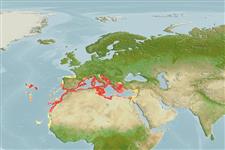Common names from other countries
>
Gadiformes (Cods) >
Phycidae (Phycid hakes)
Etymology: Phycis: Taken from Greek, phykon = seaweed; because of the habits of this fish that lives hidden among them (Ref. 45335).
More on author: Linnaeus.
Environment: milieu / climate zone / depth range / distribution range
экология
морской донно-пелагический; немигрирующий; пределы глубины 13 - 614 m (Ref. 4517), usually 100 - 200 m (Ref. 1371). Subtropical; 45°N - 13°N, 32°W - 36°E
Northeast Atlantic : Bay of Biscay to Morocco, south to Cape Verde, and including off-lying islands. Also in the Mediterranean and the Azores.
Length at first maturity / Size / Вес / Возраст
Maturity: Lm 36.0, range 32 - ? cm
Max length : 65.0 cm TL самец/пол неопределен; (Ref. 12382); common length : 25.0 cm TL самец/пол неопределен; (Ref. 1371); наибольший вес (опубликованные данные): 3.9 kg (Ref. 40637)
колючие лучи спинного плавника (общее число) : 0; колючие лучи анального плавника: 0. Elongated pelvic-fin rays reaching at most to the origin of the anal fin. Body color is brownish-red dorsally, becoming paler ventrally. Vertical fins distally dark, sometimes with a pale margin.
Found on hard and sandy-muddy bottoms near rocks at 100-650 m, but sometimes taken at greater depths (Ref. 1371). Nocturnal, hiding between rocks during the day (Ref. 1371). Feed on small fish and various invertebrates (Ref. 1371).
Cohen, D.M., T. Inada, T. Iwamoto and N. Scialabba, 1990. FAO species catalogue. Vol. 10. Gadiform fishes of the world (Order Gadiformes). An annotated and illustrated catalogue of cods, hakes, grenadiers and other gadiform fishes known to date. FAO Fish. Synop. 125(10). Rome: FAO. 442 p. (Ref. 1371)
Статус Красного Списка МСОП (Ref. 130435)
CITES (Ref. 128078)
Not Evaluated
Угроза для людей
Harmless
Использование человеком
рыболовство: не имеет хозяйственного значения
дополнительная информация
инструменты
Специальные отчеты
Скачать в формате XML
ресурсы в Интернет
Estimates based on models
Preferred temperature (Ref.
115969): 13.3 - 16.2, mean 14.9 (based on 84 cells).
Phylogenetic diversity index (Ref.
82804): PD
50 = 0.6255 [Uniqueness, from 0.5 = low to 2.0 = high].
Bayesian length-weight: a=0.00631 (0.00523 - 0.00762), b=3.15 (3.09 - 3.21), in cm Total Length, based on LWR estimates for this species (Ref.
93245).
Trophic level (Ref.
69278): 4.3 ±0.3 se; based on diet studies.
устойчивость к внешним воздействиям (Ref.
120179): средний (среднего размера), минимальное время удвоения популяции 1.4-4.4 года (K=0.19).
Fishing Vulnerability (Ref.
59153): Moderate vulnerability (45 of 100).
Climate Vulnerability (Ref.
125649): High to very high vulnerability (68 of 100).
